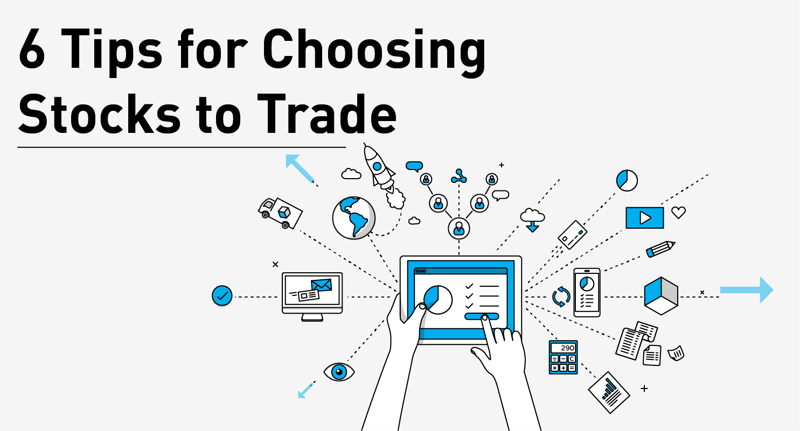Table of Contents
It’s the eternal trading dilemma: How should I go about choosing stocks to trade?
Identifying potential stocks to trade is one of the most important aspects of your trading career. But how, exactly, should it be done?
With literally thousands of options out there, it’s hard to know where to begin.
These six tips can help you get started …
Download a PDF version of this post as PDF.
1.) Look at the market at large.
Don’t just focus on the trees; look at the entire forest. Stocks tend to move with the wave of the general market. So, if the market is trending higher, this could improve your chances of making a profitable trade, no matter which stock you choose.
How can you help determine the market’s tone? Here are a few ideas:
- Mull over moving averages. Look at the moving averages of the major indexes over the past weeks and see what they’re doing right now.
- Consider the time of year. There can be a seasonal aspect to the market, and the market can definitely trend differently given the proximity to earnings season or major holidays.
- Think about market-moving events. Has there been a big economic summit or a Federal Reserve policy meeting? Big events like this can move the market.
2.) Settle on a sector.
To further narrow down your stock choices, it’s helpful to settle on a particular sector or industry. With a general idea of how the market is trending, you may already have some ideas for sectors to trade.
These tips can help you refine further:
- Follow the news. Is there a big catalyst related to an industry or sector that could move the market? Consider focusing your attentions there.
- Seek out timely stocks. Once again, the time of year can have an effect on different sectors. For instance, later in the year, when retail revs up in advance of the holidays, luxury retailer stocks may trend upward.
- Look to the GICS. If you’re not sure what industries or sectors look promising, you can look at the GICS (Global Industry Classification Standard) to see who has been rocking it recently.
3.) Set yourself to screening.
Now that you’ve figured out your sector, it’s time to start scanning …
StocksToTrade can help you filter by a variety of different criteria, including price performance, volume, technical AND fundamental indicators, along with news and earnings.
Created by traders for traders, StocksToTrade allows you to scan with ease to help you with the heavy lifting of choosing stocks to trade.
4.) Do your research.
No matter what a scan reveals, no matter how promising a sector may seem, no matter how hot a stock tip promises to be, you always must do your own research.
Research the company in question and try to figure out if there is any news afoot that could affect the stock price.
Are there positive catalysts, such as a strong earnings report, a new product launch, or a company acquisition, that could have a positive impact on the price?
On the flipside, are there any lawsuits, negative news, or anything that could bring the stock’s desirability down?
Yes, research takes time, but it’s worth the effort. After all, it’s your money going into the trade, so you want to make sure you’re covering your bases.
You might also find our recent post on 5 Things to Look For in a Company Before Investing helpful.
5.) Look at the charts.
Once you have a few strong contenders, let the numbers guide you in choosing stocks to trade.
Usually, traders want to try to take a position to take advantage of an uptrend or to take advantage of a dip if they believe the stock will revert back to a higher place.
Looking at a stock’s chart can help you determine if there’s a good entry for a trade.
Be very thorough in reviewing a stock’s chart, because its past performance can give a very good indication of how it may perform in the future.
6.) Keep track of the results.
Many traders keep track of their trades in a trading journal. However, you can likely gain even more benefits by monitoring things like how you choose stocks, as well.
If you notice that certain methods are reliably helping you identify good stock choices, then make note of them in your journal. Also, if you discover that certain sectors never seem to earn you profits, make note of things like this, as well.
Conclusion:
It’s extremely important to have a system in place for choosing stocks to trade, as this is a process that will be part of your entire trading career.
While it may seem arduous to go through these steps at first, becomes easier in time.
Developing a system for sifting through the many stocks available can help you gain perspective on the market and help you refine your trading process.
